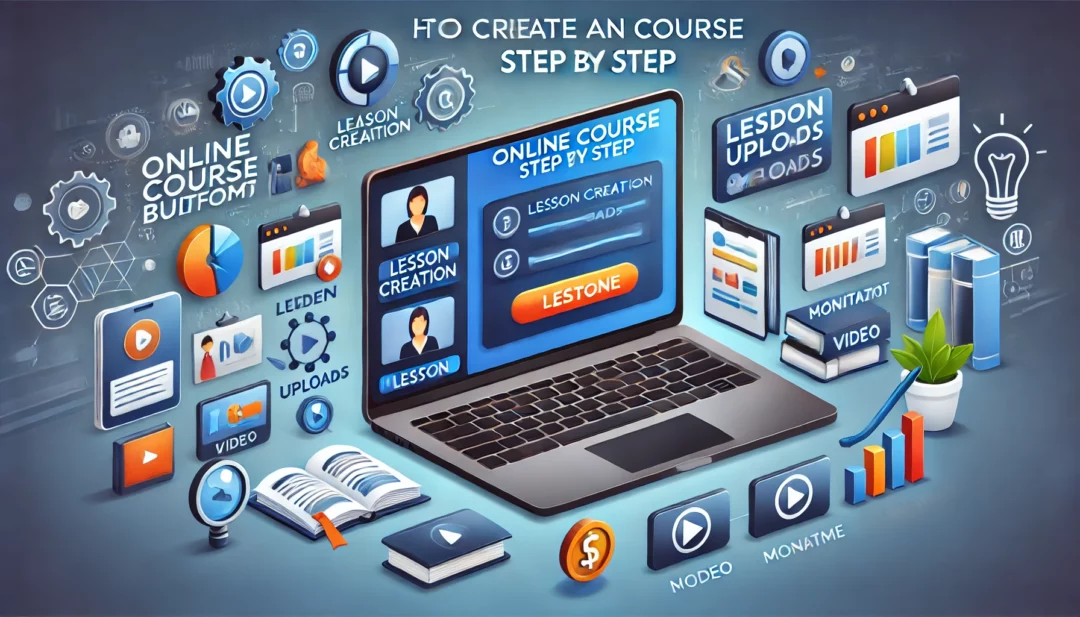
Creating an online course might seem overwhelming, but breaking it into clear steps makes the process manageable and rewarding. You’ll start by identifying your niche and understanding your audience’s needs. Once that’s clear, outline your course structure to ensure it’s organized and engaging.
Next, focus on developing high-quality content—whether it’s videos, slides, or downloadable resources. After that, select a platform to host your course and set it up for easy accessibility. Finally, launch your course and promote it effectively to reach your target audience. With the right approach, you can create a course that delivers value and builds your authority.
Understanding The Basics Of Online Course Creation
Creating an online course involves strategic planning to ensure it meets learners’ needs and delivers value. A well-planned foundation sets your course up for success.
Benefits Of Creating An Online Course
- Revenue Generation: Online courses enable you to create passive income streams, selling the same course content repeatedly without additional production costs.
- Scalability: Unlike traditional teaching, online courses let you scale your audience globally, reaching thousands of learners simultaneously.
- Flexibility: Designing courses online provides the opportunity for flexible teaching schedules and content updates to match learner demand.
- Authority Building: Sharing expertise via online courses establishes you as a credible authority in your field, opening up further professional opportunities.
- Relatable Examples: For instance, professionals in fitness can create workout modules, while marketers can teach ad optimization, connecting with target audiences effectively.
- Defined Learning Objectives: Outline clear, measurable outcomes learners will gain, ensuring relevance to your audience’s goals.
- Engaging Content: Use a mix of videos, quizzes, and interactive tasks to maintain learner engagement throughout the course.
- Organized Structure: Break the course into manageable modules, starting with easy concepts and progressively increasing complexity.
- Effective Platform: Choose platforms like Teachable or Udemy that align with your audience size, budget, and required features.
- Support System: Incorporate Q&A sessions, discussion boards, or dedicated email support to address learners’ questions.
- Marketing Strategy: Build awareness through email campaigns, social media, and collaborations with influencers to reach your target audience.
- Actionable Example: A photography course might include tutorials, assignments, and peer feedback to ensure skill development and engagement.
Planning Your Online Course
Careful planning ensures your online course meets audience needs and achieves learning objectives. Create an effective plan by focusing on understanding your audience, setting clear goals, and organizing the content logically.
Identifying Your Audience
Determine who your course is designed for by analyzing demographics, interests, and knowledge levels. Define specifics like age range, career roles, and experience levels to tailor content appropriately. Use surveys or forums to collect data on their learning preferences and challenges.
Example: A course for beginner photographers might target hobbyists aged 18–35 with little technical background. Understand their interests, like learning camera settings or editing basics, to guide your topics.
Defining Your Course Goals
Focus on clear, measurable outcomes to offer value to learners. Write goals that specify what students can achieve after completing your course. Include actionable skills or knowledge applicable in real-life scenarios.
Example: For a digital marketing course, a goal might be “Learn to design and execute a basic SEO strategy” instead of “Understand SEO.”
Structuring Your Course Content
Organize content into logical modules or sections to enhance clarity. Ensure each module builds on previous knowledge and keeps lessons manageable in size for easy consumption. Balance theory with practical applications, such as step-by-step exercises or case studies.
- Use a storyboard or outline to arrange topics sequentially.
- Include diverse formats like videos, quizzes, and downloadable resources to maintain engagement.
- Limit videos to 5–10 minutes to retain attention and simplify concepts.
Choosing The Right Tools And Platforms
Selecting the right tools and platforms ensures your online course is professional, engaging, and accessible. Focus on systems and software that enhance content delivery and learner experience.
Learning Management Systems (LMS)
An LMS serves as the backbone of your course delivery. It manages enrollment, tracks progress, and provides a user-friendly learning interface.
- Teachable: Offers customizable templates, payment integration, and data analytics for monitoring progress.
- Udemy: Provides global reach with an existing audience but limits pricing flexibility.
- Thinkific: Enables course customization and integrates marketing tools like email campaigns.
Evaluate platform features, costs, and scalability to find the best fit for your course type and audience needs.
Content Creation Tools
Content creation tools help design interactive, visually appealing materials. Choose tools based on your course format and complexity.
- Canva: Ideal for creating branded slides, infographics, and worksheets.
- Google Docs: Benefits collaboration and keeps drafts organized.
- Procreate: Useful for high-quality illustrations in design-focused courses.
Test available tools to avoid compatibility issues and ensure ease of use while maintaining professional-quality visuals.
Video Recording And Editing Software
Video is central to most online courses, making recording and editing software essential. These tools help produce engaging, high-quality video content.
- OBS Studio: Free software for screen recording tutorials or lecture-based content.
- Camtasia: Combines recording with simple editing features like captions and annotations.
- Final Cut Pro: Suitable for advanced editing with effects and transitions for professional-grade courses.
Invest in tools that match your technical proficiency to save time and effort during the production process.
Designing Engaging Course Material
Engaging course material ensures learners remain focused, absorb content effectively, and achieve their learning objectives. Use clear strategies to create compelling resources that cater to diverse learning styles.
Writing Effective Scripts And Slides
Scripts and slides support material delivery in online courses. Your scripts should include concise, conversational language to ensure clarity and relatability. Use an outline to organize information logically, with key points, transitions, and examples.
Design slides with minimal text and emphasize visuals like images, diagrams, or graphs to illustrate concepts. Limit each slide to a single idea, using bullet points to break down information. Maintain visual consistency by applying the same fonts, colors, and layouts throughout the presentation. Include a slide with actionable takeaways after each module to reinforce key learnings.
Incorporating Multimedia And Interactive Elements
Multimedia enriches your course content. Add videos for instructional segments, ensuring clear visuals, quality audio, and concise durations of 5–10 minutes. Use tools like OBS Studio for screen recordings and Canva for creating graphics.
Interactive elements, like polls, quizzes, or discussion forums, promote active participation. Include elements like clickable hotspots in videos or drag-and-drop activities in slide-based lessons to enhance interactivity. Use platforms like Nearpod or H5P to create dynamic, learner-driven experiences.
Creating Assessments And Quizzes
Assessments gauge learner progress and reinforce material. Design quizzes with varied question types, such as multiple-choice, true/false, and short answers, to test diverse cognitive skills. Ensure each question relates directly to instructional objectives.
Incorporate formative assessments like practice quizzes or discussion prompts during modules to help students monitor understanding. Use summative assessments, such as final exams or projects, to evaluate mastery of skills and concepts. Platforms like Kahoot! and Typeform can facilitate interactive quiz creation.
Marketing And Launching Your Online Course
Promoting your course effectively ensures it reaches the target audience and generates interest. Focus on strategic planning and leveraging the right tools to maximize visibility and increase enrollments.
Building A Pre-Launch Strategy
Create anticipation for your course by developing a detailed pre-launch plan. Start by identifying your ideal audience using insights from surveys, forums, or social media groups. Build curiosity by sharing teasers and valuable insights related to your topic, like short video tips or infographics. Use webinars or free previews to engage potential learners and showcase the value of your course.
Establish clear timelines for your pre-launch activities. For instance, you might dedicate 4-6 weeks to sharing promotional content or running countdown campaigns. Include lead magnets, such as free eBooks or checklists, to collect email addresses and grow your audience list.
Leveraging Social Media And Email Campaigns
Build course visibility through social media and email marketing. On social platforms, share content consistently over multiple channels like Instagram, LinkedIn, or Facebook. Use reels or carousel posts to highlight course benefits and learner outcomes. Engage your audience by hosting live Q&A sessions, running polls, or creating hashtags related to your course niche.
In email campaigns, craft compelling subject lines to increase open rates. Segment your email list to tailor messages based on user interests. For example, send exclusive discounts to early sign-ups or detailed course overviews to leads asking for more information. Schedule regular follow-ups to nurture your audience and maintain their interest.
Setting Up Pricing And Payment Options
Price your course to balance accessibility and profitability. Research competitor pricing, considering course duration, comprehensiveness, and target audience purchasing power. For example, basic-level courses might range from $50 to $150, while more advanced and niche courses could cost $200 or more. Offer tiered pricing plans or bundled packages, like including multiple courses at a discount.
Set up user-friendly payment options through platforms like Stripe or PayPal. Enable international payments if you’re targeting a global audience. Ensure secure transactions and provide invoices automatically to establish trust and professionalism.
Conclusion
Creating an online course is an opportunity to share your expertise, connect with a global audience, and build a sustainable income stream. With thoughtful planning, engaging content, and the right tools, you can deliver a learning experience that truly resonates with your audience.
By focusing on value, clear objectives, and effective promotion, your course can stand out in a competitive market. Remember, every step you take brings you closer to empowering others and establishing your authority in your niche. Now’s the time to turn your knowledge into impact.
Frequently Asked Questions
1. What is the first step in creating an online course?
The first step is identifying your niche and understanding your target audience’s needs. Focus on the topic you are knowledgeable about and determine how it can solve a problem or add value for your audience.
2. How do I structure my online course?
Organize your course into logical modules that build on each other. Define clear learning objectives, outline the content, and include a mix of engaging formats like videos, slides, and quizzes to keep learners interested.
3. What tools do I need to create an online course?
You’ll need content creation tools like Canva or Google Docs, video recording/editing software like OBS Studio or Camtasia, and a reliable Learning Management System (LMS) like Teachable, Udemy, or Thinkific to host your course.
4. How can I make my course more engaging?
Incorporate multimedia like videos, infographics, and interactive quizzes. Use concise and visually appealing slides, cater to diverse learning styles, and include assessments to keep learners actively participating and engaged.
5. What are the best platforms to host my online course?
Top hosting platforms include Teachable, Udemy, and Thinkific. They offer features like user-friendly course design, scalability, enrollment management, and built-in marketing tools to enhance the learning experience.
6. How do I market my online course?
Use email campaigns, social media, and webinars to build anticipation. Share teaser content and engage with your audience to generate interest. A pre-launch strategy and consistent marketing efforts help increase course visibility.
7. How do I determine the pricing for my course?
Research competitors to set competitive pricing. Consider the value your course provides, your target audience’s budget, and include user-friendly payment options to make the course accessible and appealing.
8. How long should course videos be?
Keep videos short and focused, ideally 5–10 minutes. Shorter videos help maintain attention, simplify complex concepts, and make it easier for learners to process information in manageable chunks.
9. What are the benefits of creating an online course?
Benefits include generating passive income, scaling to reach a global audience, creating a flexible teaching schedule, and establishing authority in your field by sharing your expertise.
10. How can I assess learner progress?
Use quizzes, assignments, and formative assessments to track progress. Include varied question types and interactive tools like Kahoot! or Typeform to reinforce learning and ensure material understanding.
11. How important is pre-launch for an online course?
Pre-launch is crucial to build anticipation and attract your audience. Share promotional content, run webinars, and engage potential learners early to maximize interest and ensure a successful course launch.
12. What learning formats work best for an online course?
A mix of videos, slides, quizzes, and downloadable resources works best. This variety caters to different learning styles and keeps the course interactive and engaging for students.



